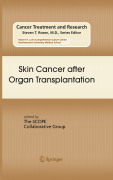
Organ transplantation has been performed for almost 40 years with steadily increasing success regarding long-time survival of the graft, as well as qualityof life for the patient. However, graft tolerance only can be achieved via induction and maintenance of an impaired immunological surveillance. An increaseof skin cancers as a consequence of the lowered cellular immuneresponse seemsto parallel the overall increased long-time survival rate of organ transplantrecipients. Against the background of chronic immunosuppression known risk factors like the amount of sun exposure prior and post transplantation, oncogenic viruses as well as the genetic background, and place of residence (latitude)are strongly related with the increased skin cancer incidence. The increasingincidence of non-melanoma skin cancer, paralleling a prolonged survival of patients after organ transplantation, represents a significant reason for morbidity and long-term morbidity in organ transplant recipients worldwide. There isan emerging need for a high-grade scientific and clinical book related to chronic immunosuppression in transplant patients (more than 1,000,000 world wide)Provides an answer on the dramatically increased skin cancer incidence in this group of patients Interdisciplinary access for interdisciplinary management of high risk patients INDICE: From the contents Historical Perspective (Past Present Future).- Immunology of organ transplantation and allograft rejection.- Posttransplant Malignancies.- Kidney Transplantation.- Heart/lung Transplantation .- Liver Transplantation.- Bone Marrow Transplantation.- Other Transplants.- Immunosuppression.- Introduction and general issues.- Calcineurin inhibitors.- MMF/MMS.- m-TOR Inhibitors.- Azathioprine.- Corticosteroids.- FTY and other new drugs.- Induction therapies.- Tolerance induction.- Skin Immune System.- Posttransplant Malignancies General Overview.- Influence of organ and pre-existing disease.- Epidemiology and Region specific features.- Europe.- USA/Canada.- Australia/Asia.- Etiological factors in cutaneous carcinogenesis.- Introduction.- Photocarcinogenesis - DNA damage.- UV-induced immunosuppression.- Mechanisms related toimmunosuppressive therapies.- Oncogenic viruses.- HPV Epidemiology.- UV-HPV Interactions.- HHV 8.- Molecular pathogenesis of BCC and SCC.- Genetic basis ofmelanoma.
- ISBN: 978-0-387-78573-8
- Editorial: Springer
- Encuadernacion: Cartoné
- Páginas: 400
- Fecha Publicación: 01/12/2008
- Nº Volúmenes: 1
- Idioma: Inglés
